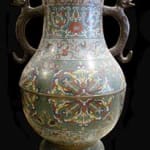Large Cloisonné Vase, 16th Century CE - 19th Century CE
Enamel
34.625
X.0606
Cloisonné is a specific type of enamel ware in which the individual colors that compose the design are segregated by thin strips of metal. The earliest examples of Cloisonné wares...
Cloisonné is a specific type of enamel ware in which the individual colors that compose the design are segregated by thin strips of metal. The earliest examples of Cloisonné wares date as far back as the Yuan Dynasty (1271-1368 A.D.) and the technique is believed to have originated in Beijing. Traditionally, the reign of Emperor Xuande (1426-1456 A.D.), who ruled during the Ming Dynasty, is sited as the period when the finest Cloisonné wares were produced. Sometimes Cloisonné is referred to as “Blue of Jingtai” in reference to the reign of Emperor Jingtai (1450-1456 A.D., coinciding with Xuande) when craftsmen discovered a dark blue enamel that gave Cloisonné wares a gorgeous, solemn look and is still frequently employed today. The technique involved in manufacturing Cloisonné wares is quite complicated, involving base hammering, making the red-copper roughcast, forming patterns on the roughcast with thin copper strips, filling patterns with enamel of different colors, firing, polishing, and in some cases gilding. During the Qianlong period (1736-1795 A.D.) of the Qing Dynasty, the skills of making Cloisonné reached their pinnacle when pure copper began to be used for roughcasts. Since the fabrication of Cloisonné integrates bronze and porcelain-working skills, traditional painting as well as etching, Cloisonné wares are considered the pinnacle of traditional Chinese crafts.



